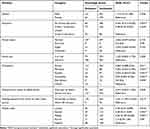Back to Journals » Clinical Ophthalmology » Volume 15
Knowledge, Attitude, Practices and Associated Factors Towards Trachoma Among People Living in Arba Minch Zuria District, Gamo Zone, Southern Ethiopia
Authors Churko C , Asfaw MA , Zerdo Z
Received 27 May 2021
Accepted for publication 5 July 2021
Published 16 July 2021 Volume 2021:15 Pages 3075—3085
DOI https://doi.org/10.2147/OPTH.S321294
Checked for plagiarism Yes
Review by Single anonymous peer review
Peer reviewer comments 2
Editor who approved publication: Dr Scott Fraser
Chuchu Churko,1 Mekuria Asnakew Asfaw,1 Zerihun Zerdo2
1Department of Public Health, College of Medicine and Health Sciences, Arba Minch University, Arba Minch, Southern Nation Nationality of People Region, Ethiopia; 2Department of Medical Laboratory Science, College of Medicine and Health Sciences, Arba Minch University, Arba Minch, Southern Nation Nationality of People Region, Ethiopia
Correspondence: Chuchu Churko Email [email protected]
Background: Trachoma is the second leading cause of blindness in the world affecting the poorest communities. Despite many interventions undertaken on prevention and control for trachoma, Ethiopia has failed to achieve the 2020 elimination goal.
Objective: To assess knowledge, attitude, practice and its associated factors toward trachoma infection among people living in Arba Minch Zuria district Gamo zone, Southern Ethiopia.
Methods: A community-based cross-sectional study was conducted from December 2019 to June 2020. Data were collected using a pretested interviewer-administered questionnaire from 796 randomly selected individuals. Epi Info version 7 was used to enter and clean the data and exported to SPSS V20 for analysis. A multivariable logistic regression analysis model was fitted to identify factors associated with the outcome variables.
Findings: Among 796 interviewed participants, 611 (76.8%) had inadequate knowledge toward trachoma infection and 244 (30.7%) had unfavorable attitude. Individuals who had no formal education (AOR=0.365, 95%CI: 0.212– 0.626) and primary education (AOR=0.58, 95%CI: 0.35– 0.962) were negatively associated with adequate knowledge towards trachoma infection. Being a farmer (AOR=0.063, 95%CI: 0.008– 0.52), merchant (AOR=0.022, 95%CI: 0.003– 0.194), student (AOR=0.026, 95%CI: 0.003– 0.225) or housewife (AOR=0.03, 95%CI: 0.004– 0.256) were negatively associated with adequate knowledge. Those study subjects whose wealth index were lowest (AOR=0.49, 95%CI: 0.27– 0.878), second (AOR=0.38, 95%CI: 0.21– 0.69) and middle (AOR=0.36, 95%CI: 0.199– 0.658) percentiles negatively associated with adequate knowledge. A short distance to fetch water (AOR=2.53, 95%CI: 1.18– 5.415) was positively associated with adequate knowledge about trachoma infection. Environmental cleanliness (AOR=2.224, 95%CI: 1.518– 3.257), being male (AOR=1.848, 95%CI: 1.332– 2.565) and distance from home to health facility (AOR=1.845, 95%CI: 1.308– 2.600) were significantly associated with attitude status.
Conclusion: Considerable numbers of people have unfavorable attitude and inadequate knowledge about trachoma infection. Awareness creation through community mobilization and sensitization should be strengthened.
Keywords: trachoma, Arba Minch Zuria, trichiasis, Ethiopia
Introduction
Trachoma is a preventable and treatable disease and the second leading cause of preventable blindness in the world affecting mostly the poorest communities. Repeated infection of children with Chlamydia trachomatis can lead to scarring of the conjunctiva, causing entropion in adults as the eyelid turns inward, and trichiasis as the eyelashes deviate inward and touch the globe. Damage to the cornea from trichiasis, as well as abnormal conjunctiva, can result in vision loss.1
The World Health Organization (WHO) simplified classification of trachoma infection as follicular trachoma (TF), inflammatory trachoma (TI), trachomatous scarring (TS), trachomatous trichiasis (TT) and corneal opacity (CO). TF is described as of at least 0.5 mm in the upper tarsal conjunctiva; pronounced inflammatory thickening of the tarsal. TI is when the conjunctiva obscures more than half of the deep normal tarsal vessels. TS is described as the presence of scarring in the tarsal conjunctiva and CO means the presence of easily visible corneal opacity which obscures at least some of the pupil.2
The WHO had launched an initiative to eliminate blinding trachoma by the year 2020 using the SAFE strategy: Surgery, Antibiotic, Facial cleanliness and Environmental improvement.3 Surgical correction of the upper eyelid using tarsal rotation procedure is the most effective intervention for trichiasis. Trachomatous trichiasis surgery treatment is provided free or subsidized in most trachoma endemic settings.4
Trachoma remains a problem in the poorest societies of the world. As of 2014, an estimated 21 million people were afflicted with active trachoma, 7.3 million of whom have trichiasis and 2.2 million of whom are either completely blind or severely visually impaired. The majority of this blinding trachoma occurs in African countries.5 According to the WHO weekly epidemiological record 2019, 142.2 million people live in trachoma endemic areas and 2.5 million people require urgent surgery to trachomatous trichiasis, the late stage of blinding trachoma.6
In 2017, 70 million people lived in trachoma-endemic areas in Ethiopia; that is 44% of the global burden of active trachoma.7 Trachoma is the second most common cause of blindness in Ethiopia exceeded only by trachoma where trichiasis affects 3% of people above 14 years of age.8 According to the national survey conducted in 2006, trachoma accounts for 11.5% of all blindness and 7.7% of people with low vision. It is estimated that over 138,000 people in Ethiopia are already blinded by this disease.9
In the Southern Nations, Nationalities and People’s Region (SNNPR), where ORBIS implements its rural program and trachoma control initiatives, the prevalence is even higher. Based on evidence generated from district baseline trachoma surveys in ORBIS supported rural project areas, the prevalence of active trachoma ranges from 22% to 56% and that of trachomatous trichiasis from 1.1% to 6.4%.10 More recent evidence showed that the Arba Minch Zuria district has the highest TT backlog in Gamo zone, Southern Ethiopia.10
Despite the scale-up of different interventions done in Ethiopia like annual and biannual mass drug administration for trachoma and surgical services in recent years, the disease is still a public health problem affecting the people living remote kebeles and who have a poor economic status. We hypothesized that the disease is still a public health problem because of inadequate knowledge and attitude toward trachoma prevention and control measures. Therefore, the aim of this study was to assess knowledge and attitude among communities living in Arba Minch Zuria district, Gamo zone, Southern Ethiopia.
Methods and Materials
Study Setting and Design
A community-based cross-sectional study was conducted from December 2019 to June 2020 in Arba Minch Zuria district in Gamo zone. The district has a high prevalence of TT backlog. According to the ORBIS international Ethiopia report, the district has an estimated TT backlog of 511. Gamo zone is one of the zones in the SNNP region of Ethiopia. The zone is located 505 km south from Addis Ababa, having 13 districts and four city administrations. According to the 2007 Ethiopian central statistics agency census, the zone had a total population of 1,341,901 of which 668,230 were men and 673,671 were women. Majority of the population 1,292,653 (96.33%) live in rural area. The current profile indicated that there are five hospitals, 33 private clinics and 53 health centers in the recently formed Gamo zone.
Source and Study Population
Source population: all individuals who were aged 18 years and above in the selected district.
Study population: randomly selected individuals who were aged 18 years and above in the selected district.
Eligibility Criteria
Inclusion criteria: all individuals who were aged 18 years old or above in randomly selected kebeles were eligible population for this study. They could be healthy volunteers who were clinically diagnosed and treated trachoma cases or status unknown.
Exclusion criteria: those individuals who were severely ill and absent after two visits during the data collection period.
Sample Size
Sample size was determined using standard procedures by considering the following assumptions: Zα/2=significance level at 95% confidence interval=1.96; P=60% proportion people who had adequate knowledge towards trachoma;11 degree of margin=5%; design effect of 2 and 10% nonresponse rate, the final sample size was 811.
Sampling Procedure
Multistage sampling technique was used in this study. Five out of the total 18 kebeles found in the district were selected randomly. The total sample size was allocated proportionally to the size of households in each of the selected kebeles. The sampling frame was obtained from health extension workers for selection of households. Systematic sampling technique was employed to select 811 study participants from five kebeles of the district. The sampling interval was calculated by dividing the total number of households in each kebele with the total number of households selected from each kebele. A fixed starting point was selected in each kebele to have first household for interview and then direction was randomly selected to proceed to the next house. Then, every Kth household was selected until the required sample size was obtained from each selected kebele. If there were more than one eligible individual in the selected house, only one participant was selected by using the lottery method (Figure 1).
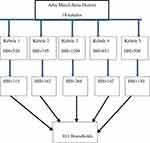 |
Figure 1 Schematic presentation of sampling procedure of the study participants. Note: HH means households. |
Data Quality Control
To maintain data quality, the data collection tool was pretested with 5% of the sample size. Initially a semistructured questionnaire with closed and open-ended questions was prepared in English, and then translated to Amharic and back to English to check consistency. Two-day intensive training was given for data collectors and supervisors who had previous experience in data collection. Daily supervision was carried out to check the completeness and consistency of the questionnaire.
Operational Definition
Knowledge: 18 questions were used to assess knowledge of the participants regarding trachoma infection. A score of 1 was given for correct answers and 0 for incorrect answers. If the study subjects scored the mean or more of correct knowledge questions, then he/she had adequate knowledge. A person has inadequate knowledge when he/she responded below the mean of knowledge questions.
Attitude: in this study attitude was categorized as favorable and unfavorable attitude based on eight attitude questions. Code 1 was given for correct answers and code of 0 for incorrect answers. Individuals who scored the mean or more of the attitude question were categorized as having favorable attitude and score below the mean were categorized as unfavorable attitude.
Study Variables
Dependent variables
- Knowledge
- Attitude
Independent variables
- Sociodemographic variables
- Personal hygiene factors
- Environmental sanitation factors
- Health system related factors
Data Collection
A pretested, semi-structured interviewer-administered questionnaire was prepared for data collection. The questionnaire contained variables on sociodemographic, clinical characteristics, personal hygiene, and environmental sanitation factors. Individuals who fulfill the inclusion criteria were identified by trained data collectors. Sixteen data collectors whose professions were health background and had experience in data collection were recruited for this study. Then, the data collectors visited house-to-house and interviewed the study subjects using the pretested tool.
Data Processing and Analysis
Epi Info version 7 was used for coding, entering and cleaning the collected data and the data were imported and analyzed using SPSS version 20. Bivariate analysis was done to determine the associations between each independent variables and outcome variables. All associated factors with P-value less than 0.25 during bivariate analysis were entered into a multivariable logistic regression model. Odds ratio with 95% confidence intervals were used to see the strength of association between different variables. P-value and 95% confidence interval (CI) for odds ratio (OR) were used in deciding the significance of the associations. Before inclusion of independent factors, multicollinearity was checked using cutoff points variance inflation factor (VIF) <10 and normality was checked by Q-Q probability plots. Hosmer–Lemeshow goodness of fit was also checked for the model at P-value >0.05.
Results
Sociodemographic Characteristics of the Study Subjects
A total of 796 study participants from five kebeles of Arba Minch Zuria district were interviewed with a response rate of 98.2%. The mean age of the study subjects was 38.9 with standard deviation of ±11.6 years. The minimum and maximum ages were 18 and 90 years old, respectively. Most 462 (58%) of the respondents were males. More than half of the participants were Protestant religion, followed by Orthodox, 459 (57.7%) and 333 (41.8%) respectively. Regarding level of education, 345 (43.3%) of the study subjects had no formal education. Most, 666 (83.7%) of the respondents, were married whereas only 10.7% were single in their marital status (Table 1).
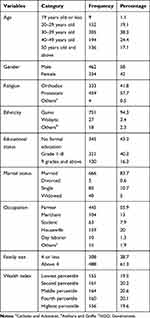 |
Table 1 Sociodemographic Characteristics of the Study Subjects, (N=796) |
Clinical Characteristics, Personal and Environmental Hygiene Practice of Study Subjects
Of the total respondents, 58 (7.3%) and 56 (7%) experienced eyelashe epilation and discharge present in their eyes. Regarding personal hygiene, 329 (41.3%) of the study subjects washed their face once per day and 109 (13.7%) did not use soaps while washing face. One hundred and thirty (16.3%) of the participants had the habit of sharing clothes. In contrast, feces were present in the environment of 63 (7.9%) of the study participants. Forty-two (5.3%) of the study subjects said that they had no latrine at all. More than half 459 (57.7%) of the study subjects spent more than one hour walking distance to reach a health facility. Eighty-five (10.7%) the participants spent more than 30 minutes fetching clean water (Table 2).
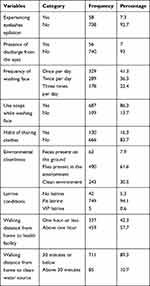 |
Table 2 Clinical, Personal and Environmental Characteristics of the Study Participants, 2019 |
Knowledge of Community Towards Trachoma and Trichiasis
All 796 (100%) of the study subjects had heard about trachoma. However, 366 (46%) and 436 (54.8%) of them had not heard about trichiasis and trichiasis surgery, respectively. Two hundred and sixty-three (33%) of the respondents correctly answered the cause of trachoma. Regarding transmission of trachoma, 167 (21%), 160 (20.1%), and 592 (74.4%) of the study subjects correctly responded that contact with discharges, sharing clothes or fomites and unhygienic environment were roots of transmission for trachoma, respectively. Less than one quarter, 185 (23.2%) of the study subjects had adequate knowledge toward trachoma (Table 3).
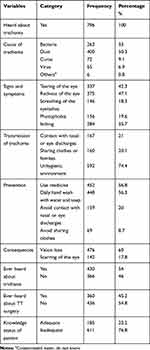 |
Table 3 Knowledge of Community Toward Trachoma and Trichiasis in Arba Minch Zuria District, Gamo Zone, Southern Ethiopia, 2019 |
The sources of information for trachoma infection were health professionals 447 (56.2%), radio/TV 203 (25.5%), friends/neighbors 164 (20.6%) and others 95 (11.9%) (Figure 2).
 |
Figure 2 Sources of knowledge of study subjects toward trachoma in Arba Minch Zuria district, Gamo zone, Southern Ethiopia, 2019. Note: aLocal meetings, churches/mosques. |
Attitude of Study Participants About Trachoma and Trichiasis Surgery
Five hundred and fifty-two (69.3%) of the study participants had a favorable attitude toward trachoma infection (Figure 3). According to this study, 148 (18.6%) strongly agreed that trachoma could be transmitted through hereditary. Conversely, 240 (30.1%) were neutral and 144 (18.1%) disagreed that trichiasis patients might lose vision if not operated upon. Half, 398 (50%) of the study subjects disagreed that people with trichiasis could perform work like anyone without trichiasis. Ninety-three (11.7%) and 185 (23.2%) of the respondents strongly agreed and agreed that they feared that trichiasis surgery by itself caused blindness, respectively (Table 4).
 |
Table 4 Attitude of Study Subjects Toward Trachoma and Trichiasis in Arba Minch Zuria District, Gamo Zone, Southern Ethiopia, 2019 |
 |
Figure 3 Attitude status of the study participants towards trachoma and trichiasis surgery in Arba Minch Zuria district, Gamo zone, Southern Ethiopia, 2019. Note: aLocal meetings, churches/mosques. |
Factors Associated with Knowledge of Study Participants
In multivariable logistic regression analysis, education, occupation, walking distance from home to clean water source and wealth index were significantly associated with knowledge status of the participants. Study subjects who had no formal education and grade 1–8 were 36.5% and 58% less likely to have adequate knowledge when compared to the counterpart, respectively.
Study subjects who had no formal education (AOR=0.365, 95%CI: 0.212–0.626) and primary grade level (AOR=0.58, 95%CI: 0.35–0.962) were lower chance of having adequate knowledge towards trachoma infection than those who were grade 9 and above educational background. Similarly those who were farmers (AOR=0.063, 95%CI: 0.008–0.52), merchants (AOR=0.022, 95%CI: 0.003–0.194), students (AOR=0.026, 95%CI: 0.003–0.225) and housewife (AOR=0.03, 95%CI: 0.004–0.256) were less likely to have adequate knowledge than others (government or NGO workers). The study subjects who fetch clean water by walking 30 minutes or less were 2.5 times more likely to have adequate knowledge than their counterparts, (AOR=2.531, 95%CI: 1.183–5.4150) (Table 5).
The study participants who were in the category of lowest (AOR=0.49, 95%CI: 0.27–0.878), second (AOR=0.38, 95%CI: 0.21–0.69) and middle (AOR=0.36, 95%CI: 0.199–0.658) percentiles had less probability of having adequate knowledge when compared to highest wealth index (Table 5).
Factors Associated with Attitude of Study Participants
In multivariable logistic regression analysis, home environment cleanliness, sex, age and distance from home to health facility were significantly associated with attitude of the study subjects toward trachoma infection. Those individuals who had a clean home environment (AOR=2.224, 95%CI: 1.518–3.257) were twice as likely to have favorable attitude when compared to others. Males (AOR=1.848, 95%CI: 1.332–2.565) had 1.8 times more chance of having favorable attitude than females. Younger age groups (20 years old or below (AOR= 2.746, 95%CI: 1.052–7.167), 21–30 years old (AOR=3.019, 95%CI: 1.782–5.114), 31–40 years old (AOR=2.341, 95%CI: 1.468–3.731) were positively significantly associated with favorable attitude than older people. Walking distance from home to health facility was significantly associated with attitude status of the study subjects. The study subjects whose walking distance from home to a health facility was one hour or less (AOR=1.845, 95%CI: 1.308–2.60) were 1.845 times more chance of having favorable attitude than those individuals who walk more than one hour to reach a health facility (Table 6).
Discussion
In the current study all of the respondents had ever heard about trachoma infection. This result was almost similar with studies conducted in Northern Ethiopia (89.2%), Southern Ethiopia (92.6%), and Bangladesh (86%).11–13 However, it is much higher than the research report from Kenya in which about 65.7% of the respondents had ever heard about trachoma.14 This might indicate that community mobilization and sensitization has been conducted in the study sites.
Findings of this study have shown that only 23.2% of the study subjects had adequate knowledge about trachoma infection. Only 33% of the subjects correctly answered the cause of trachoma. Significant number of the respondents (46%) and (54.8%) had not ever heard about trichiasis and trichiasis surgery, respectively. This result is much lower than a study done in Zala district in which about 60% of the households had adequate knowledge toward trachoma.11 The possible explanation for this finding might be community-based trachoma intervention especially on the awareness creation has been decreased from time-to-time and concerned bodies have changed their duties to other issues.
The present study revealed that 21%, 20.1%, and 74.4% of the respondents reported correctly that trachoma can be transmitted through contact with discharges, sharing clothes or fomites and unhygienic environment, respectively. This finding is in line with a study done in Kenya in that only one third and 35% of the participants correctly knew that flies and not washing your face were important predictors for the transmission of trachoma disease, respectively.15
According to this study, 18.6% strongly agreed and more than 25% were unsure that trachoma can be transmitted through genes. In contrast, 11.7% and 23.2% of the respondents strongly agreed and agreed that they feared that trichiasis surgery by itself caused blindness, respectively. The likely reason would be lack of awareness of the participants towardtrachoma and trichiasis.
The present study showed that education of the respondents was significantly associated with knowledge on trachoma. Those study subjects who had no formal education and grade 1–8 were 36.5% and 58% less likely to have adequate knowledge when compared to their counterparts, respectively. This result is consistent with a study done in Kenya in which a significant proportion of individuals who had no formal or primary education had inadequate knowledge regarding trachoma.15 The possible explanation of this finding would be the fact that people who had a higher educational background had better exposure to different media and information.
Those respondents who were working in nongovernmental or governmental organizations had significantly adequate knowledge on trachoma than others. Being a farmer, merchant, student or housewife were negatively associated with adequate knowledge. Although these are the most at-risk groups for trachoma infection, they had inadequate knowledge toward the disease.
The study subjects who fetch clean water by walking 30 minutes or less were 2.5 times more likely to have adequate knowledge than those who fetch water from above 30 minutes walking distance. This might be due to people who had no access to clean water supply might also be far away from social media accessibility. They might have poor infrastructures including health service, information, education, and communications (IECs) might be inadequate in the area.
Individuals with the highest wealth percentiles had a positively higher chance of having adequate knowledge than other percentiles. People who have better economic status will have better opportunities of access to social media and communication with educated persons.
According to this study about 69% of the study subjects had favorable attitude toward trachoma infection. This finding is consistent with studies done in India and other areas.16,17 The possible explanation might be awareness creations in the study area were given previously by different organization.
Presence of clean environment was positively associated with favorable attitude of the study subjects. People who had a clean environment were twice as likely to have favorable attitude than those who have an unclean environment. Similarly, a study in Kenya showed that most of the respondents linked a dirty environment with trachoma.18 That is why in this study individuals with a favorable attitude make their environment clean.
The present study revealed that male individuals had 1.8 times more chance of having favorable attitude than females. This finding might indicate that in the rural settings females were busier in home duties and had awareness gap than males. Conversely, younger study participants were positively significantly associated with favorable attitude. The reason might be because younger people were closer to social media and acquire more recent scientific information about diseases.
In the current study, the study subjects who were living in areas where the health facility is not more than one hour away had positive association with favorable attitude. This might indicate that people who live in far distance from health facility get inadequate information, education and communication towards trachoma infection.
Conclusion and Recommendation
In this study, despite high favorable attitude toward trachoma infection, the proportion of people who had adequate knowledge about trachoma was low. Education, occupation, walking distance from home to clean water source and wealth index were significantly associated with knowledge status of the participants. In contrast, environmental cleanliness, sex, younger age, and distance from home to health facility were significantly associated with favorable attitude of the study subjects toward trachoma infection. Awareness creation through community mobilization and sensitization should be strengthened to increase knowledge and attitude of residents on trachoma infection. Special attention should be given on treatment and other prevention measures of trachoma to those residents who live a far distance from health facilities.
Abbreviations
AMU, Arba Minch University; AOR, adjusted odds ratio; CI, confidence interval; CO, corneal opacity; IECs, information, education and communication; IRB, Institute Research Review Board; NGO, nongovernmental organization; OR, odds ratio; SAFE, Surgery, Antibiotic, Facial cleanliness, Environmental hygiene; SNNPR, Southern Nations Nationalities and People's Region; SPSS, Statistical Package for Social Sciences; TF, trachomatous follicular; TI, trachomatous intense; TS, trachomatous scarring; trachomatous trichiasis; VIF, variance inflation factor; WHO, World Health Organization.
Data Sharing Statement
The datasets during and/or analyzed during the current study are available from the corresponding author on reasonable request.
Ethical Approval and Consent to Participate
This study was conducted in accordance with the Declaration of Helsinki. Ethical approval was obtained from Arba Minch University (AMU) Institute Research Review Board (IRB). Support letter was obtained from the district health offices to facilitate the data collection. Informed verbal consent was obtained from each study participants before proceeding to data collection. The objective of the study was explained for each selected kebele administration. All individuals were advised about the disease complication and its prevention measures after data collection.
Acknowledgments
We would like to express our deepest gratitude and appreciation to lord of wisdom, God. We are grateful to Arba Minch University Collaborative Research Training Centre for Neglected Tropical Diseases for their full sponsorship of this research work. We are also grateful to all data collectors and supervisors, who tried their best and committed themselves to data collection.
Author Contributions
All authors made a significant contribution to the work reported, whether that is in the conception, study design, execution, acquisition of data, analysis and interpretation, or in all these areas; took part in drafting, revising or critically reviewing the article; gave final approval of the version to be published; have agreed on the journal to which the article has been submitted; and agree to be accountable for all aspects of the work.
Funding
This study was funded by the Arba Minch University, College of Medicine and Health Sciences, collaborative research and training centre.
Disclosure
The authors report no conflicts of interest in this work.
References
1. Bickley RJ, Mkocha H, Munoz B, West S. Identifying patient perceived barriers to trichiasis surgery In Kongwa District, Tanzania. PLoS Negl Trop Dis. 2017;11(1):e0005211. doi:10.1371/journal.pntd.0005211
2. Lavett DK, Lansingh VC, Carter MJ, Eckert KA, Silva JC. Will the SAFE strategy be sufficient to eliminate trachoma by 2020? Puzzlements and possible solutions. Sci World J. 2013;2013:1–18. doi:10.1155/2013/648106
3. World Health Organization. Future approaches to trachoma control: report of a global scientific meeting, Geneva, 17–20 June 1996. World Health Organization; 1997.
4. World Health Organization. Report of the 21st meeting of the WHO alliance for the global elimination of trachoma by 2020, Geneva, Switzerland, 20-22 April 2017. Geneva: World Health Organization; 2019.
5. Taylor HR, Burton MJ, Haddad D, West S, Wright H. Trachoma. Lancet. 2014;384(9960):2142–2152. doi:10.1016/S0140-6736(13)62182-0
6. World Health Organization. Weekly epidemiological record. Weekly Epidemiological Record. 2019;94(17):197–212.
7. World Health Organization. Weekly Epidemiological Record. Weekly Epidemiological Record. 2018;93(26):369–380.
8. Meshesha TD, Senbete GH, Bogale GG, et al. Determinants for not using Trachomatous trichiasis surgery in Mehalsayint District, North-East Ethiopia. PLoS Negl Trop Dis. 2018;12(7):e0006669. doi:10.1371/journal.pntd.0006669
9. Berhane Y, Worku A, Bejiga A, et al. National survey on blindness, low vision and trachoma in Ethiopia: methods and study clusters profile (2006). Ethiop J Health Dev. 2007;21(3):185–203.
10. ORBIS International. International coalation for trachoma control. Available from: http://www.trachomacoalition.org/about-ictc/members/orbis-international.
11. Mengistu K, Shegaze M, Woldemichael K, Gesesew H, Markos Y. Prevalence and factors associated with trachoma among children aged 1–9 years old in Zala district, Gamo Goffa zone, Southern Ethiopia; 2014. Clinical Ophthalmology. 2016;10:1663–1670. doi:10.2147/OPTH.S107619
12. Islam FMA, Chakrabarti R, Islam SZ, Finger RP, Critchley C. Factors associated with awareness, attitudes and practices regarding common eye diseases in the general population in a rural district in Bangladesh: the Bangladesh population-based diabetes and eye study (BPDES). PLoS One. 2015;10(7):e0133043. doi:10.1371/journal.pone.0133043
13. Gebretnsae H, Mamo N, Teklemariam T, et al. Knowledge, attitudes, and practices about trachoma in rural communities of Tigray Region, Northern Ethiopia: implications for prevention and control. J Environ Public Health. 2020;2020:8. Article ID 3270530. doi:10.1155/2020/3270530
14. Ng’etich AS, Owino C, Juma A, Khisa KN. Knowledge, attitudes and eye care seeking practices regarding trachoma in Central Division of Kajiado County, Kenya. J Public Health Africa. 2015;6(1). doi:10.4081/jphia.2015.531
15. Munguti PN. Knowledge, practices and perceptionss of trachoma and its’ influence (association with) on health seeking behaviour of patients inKajiado Central Sub County, Kajiado County, Kenya [Phd dissertation]. COHES, JKUAT; 2016.
16. Owsley C, McGwin G, Scilley K, Girkin C, Phillips J, Searcey K. Perceived barriers to care and attitudes about vision and eye care: focus groups with older African Americans and eye care providers. Invest Ophthalmol Vis Sci. 2006;47:2797–2802. doi:10.1167/iovs.06-0107
17. Nirmalan PK, Katz J, Robin AL, et al. Utilisation of eye care services in rural south India: the Aravind Comprehensive Eye Survey. Br J Ophthalmol. 2004;88(10):1237–1241. doi:10.1136/bjo.2004.042606
18. Karimurio J, Llako HS, Gichangi M, Kilima P. Prevalence of Trachoma in Kenya. East Afr Med J. 2004;83(4):63–68.
 © 2021 The Author(s). This work is published and licensed by Dove Medical Press Limited. The full terms of this license are available at https://www.dovepress.com/terms.php and incorporate the Creative Commons Attribution - Non Commercial (unported, v3.0) License.
By accessing the work you hereby accept the Terms. Non-commercial uses of the work are permitted without any further permission from Dove Medical Press Limited, provided the work is properly attributed. For permission for commercial use of this work, please see paragraphs 4.2 and 5 of our Terms.
© 2021 The Author(s). This work is published and licensed by Dove Medical Press Limited. The full terms of this license are available at https://www.dovepress.com/terms.php and incorporate the Creative Commons Attribution - Non Commercial (unported, v3.0) License.
By accessing the work you hereby accept the Terms. Non-commercial uses of the work are permitted without any further permission from Dove Medical Press Limited, provided the work is properly attributed. For permission for commercial use of this work, please see paragraphs 4.2 and 5 of our Terms.

